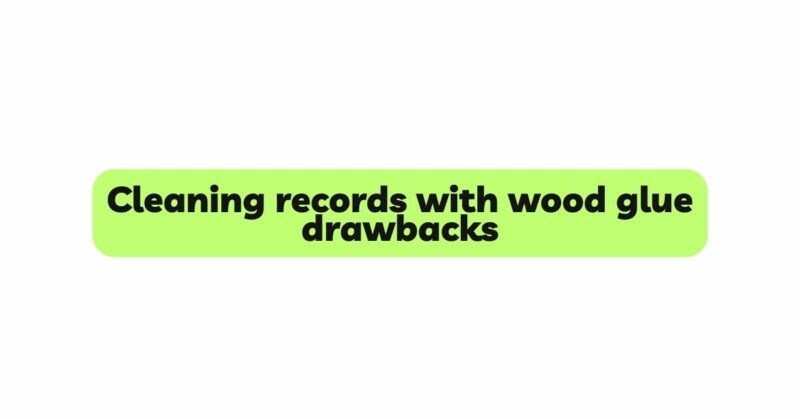The resurgence of vinyl records has brought about a renewed interest in preserving and maintaining these timeless musical treasures. Vinyl enthusiasts and collectors are constantly on the lookout for effective and affordable cleaning methods to ensure optimal sound quality and longevity of their cherished records. One unconventional method that has gained popularity in recent years involves cleaning vinyl records with wood glue. Proponents of this technique claim that it can effectively remove dirt, dust, and grime from the grooves, improving playback quality. However, there are significant drawbacks and risks associated with using wood glue for vinyl record cleaning. In this article, we will delve into the drawbacks of this method and explore safer alternatives for maintaining vinyl collections.
Understanding the Wood Glue Method:
The wood glue method involves applying a layer of wood glue to the surface of a vinyl record and allowing it to dry completely. Once dried, the glue is peeled off, allegedly carrying away embedded dirt, dust, and contaminants from the record’s grooves. The proponents of this method argue that wood glue is gentle, non-abrasive, and cost-effective compared to specialized vinyl cleaning solutions. However, this technique has garnered mixed reviews, and many experts caution against its use due to its potential drawbacks.
Drawbacks of Cleaning Records with Wood Glue:
- Risk of Irreversible Damage:
One of the most significant drawbacks of the wood glue method is the risk of causing irreversible damage to vinyl records. Vinyl is a sensitive material, and the wrong application of wood glue can lead to warping, surface abrasions, and other forms of harm. If the glue is not peeled off correctly, it may leave residue on the record, affecting sound quality and damaging the stylus.
- Potential for Residue Buildup:
Even when applied and removed properly, wood glue can leave behind a residue on the vinyl’s surface. This residue can attract dust and other contaminants, leading to more frequent cleanings and ultimately affecting the record’s sound quality over time.
- Time-Consuming Process:
Cleaning records with wood glue is a time-consuming process that requires significant patience and attention to detail. Applying the glue evenly, allowing it to dry, and removing it without damaging the vinyl demands meticulousness. For collectors with large vinyl collections, this method may not be practical due to the time investment.
- Incomplete Cleaning:
While the wood glue method may effectively remove surface-level dust and debris, it might not reach embedded contaminants deep within the grooves. Traditional record cleaning machines or brushes are better equipped to access and remove particles trapped in the record’s microgrooves.
- Variability in Glue Formulations:
Different brands and formulations of wood glue may vary in their composition, drying time, and adhesion properties. This variability can lead to unpredictable results, making it challenging to ensure consistency and safety across different records.
- Potential for Residue on Labels and Sleeves:
When using wood glue to clean vinyl records, there is a risk of the glue coming into contact with the record’s label or sleeve. If not careful, this can lead to irreparable damage to the label artwork or sleeve material.
- Voiding Record Warranties:
Using wood glue or any unconventional method for cleaning records may void the warranty of newly purchased vinyl records. Many manufacturers explicitly state that any form of cleaning beyond the manufacturer’s recommended methods can invalidate the warranty.
Safer Alternatives for Vinyl Record Cleaning:
- Record Cleaning Machines:
Investing in a reputable record cleaning machine is a safe and efficient way to clean vinyl records. These machines use vacuum suction and specially formulated cleaning solutions to remove dirt and contaminants from the grooves effectively.
- Anti-Static Brushes and Cloths:
Anti-static brushes and microfiber cloths are gentle tools designed specifically for cleaning vinyl records. They can effectively remove surface-level dust and are safe to use regularly.
- Specialized Vinyl Cleaning Solutions:
Numerous vinyl cleaning solutions are specifically designed to clean records without causing any harm. Look for solutions that are alcohol-free and have a neutral pH level to ensure the safety of your records.
- Cleaning Tips:
Follow these general cleaning tips to keep your vinyl records in optimal condition:
a. Handle records by their edges to avoid fingerprints and smudges. b. Use inner sleeves to protect the record’s surface and label. c. Store records vertically to prevent warping. d. Keep records in a dust-free environment and away from direct sunlight.
Conclusion:
While the wood glue method for cleaning vinyl records has gained popularity among some collectors, it is essential to be aware of its drawbacks and potential risks. The delicate nature of vinyl records makes them susceptible to damage, and unconventional cleaning methods like using wood glue can do more harm than good. Instead, opt for safer alternatives like record cleaning machines, anti-static brushes, and specialized vinyl cleaning solutions. By adopting proper cleaning practices and handling techniques, vinyl enthusiasts can ensure the longevity and pristine sound quality of their treasured record collections.


